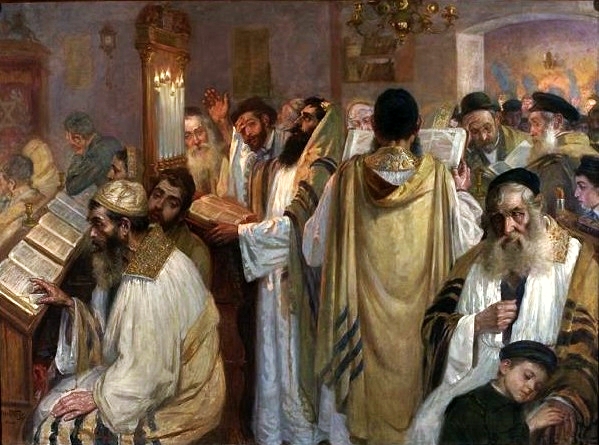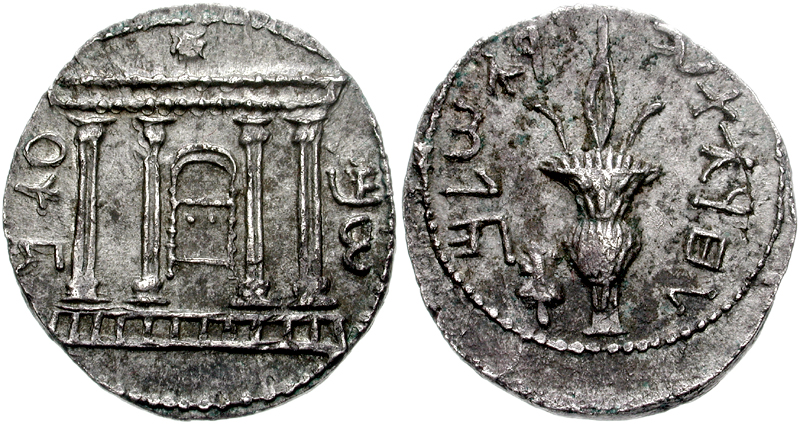|
Yom Kippur
Yom Kippur ( ; , ) is the holiest day of the year in Judaism. It occurs annually on the 10th of Tishrei, corresponding to a date in late September or early October. For traditional Jewish people, it is primarily centered on atonement and repentance. The day's main observances consist of full fasting and asceticism, both accompanied by extended prayer services (usually at synagogue) and sin confessions. Some minor Jewish denominations, such as Reconstructionist Judaism, focus less on sins and more on one's goals and accomplishments and setting yearly intentions. Alongside the related holiday of Rosh Hashanah, Yom Kippur is one of the two components of the High Holy Days of Judaism. It is also the last of the Ten Days of Repentance. Name The formal Hebrew name of the holiday is , 'day fthe atonements'. This name is used in the Bible, Mishnah, and Shulchan Aruch. The word 'atonement' is one of many Biblical Hebrew words which, while using a grammatical plural form, ... [...More Info...] [...Related Items...] OR: [Wikipedia] [Google] [Baidu] |
Judaism
Judaism () is an Abrahamic religions, Abrahamic, Monotheism, monotheistic, ethnic religion that comprises the collective spiritual, cultural, and legal traditions of the Jews, Jewish people. Religious Jews regard Judaism as their means of observing the Mosaic covenant, which they believe was established between God in Judaism, God and the Jewish people. The religion is considered one of the earliest monotheistic religions. Jewish religious doctrine encompasses a wide body of texts, practices, theological positions, and forms of organization. Among Judaism's core texts is the Torah—the first five books of the Hebrew Bible—and a collection of ancient Hebrew scriptures. The Tanakh, known in English as the Hebrew Bible, has the same books as Protestant Christianity's Old Testament, with some differences in order and content. In addition to the original written scripture, the supplemental Oral Torah is represented by later texts, such as the Midrash and the Talmud. The Hebrew ... [...More Info...] [...Related Items...] OR: [Wikipedia] [Google] [Baidu] |
Jews Praying In The Synagogue On Yom Kippur
''Jews Praying in the Synagogue on Yom Kippur'' was painted by Polish-Jewish artist Maurycy Gottlieb in 1878. It depicts Jews in the midst of the Yom Kippur service, on one of the holiest days of the Jewish calendar. Yom Kippur is the Jewish holiday of repentance, a time for Jews to repent for their sins and reflect on their behaviour in the past and coming year. As Soussloff writes in Jewish Identity in Modern Art History, "Yom Kippur is also the occasion in the Jewish year when the dead are solemnly commemorated (in the service called Yizkor), and Gottlieb has injected into this picture several prominent self-memorials." In his book Painting a People, Ezra Mendelsohn confirms that Gottlieb’s subject in this painting is the Days of Atonement: "Nathan Samuely, who discussed the work with Gottlieb in 1878, does specifically connect it, in his German essay on the artist published in 1885, with Yom Kippur, and informs us that the artist himself had the idea of painting it during ... [...More Info...] [...Related Items...] OR: [Wikipedia] [Google] [Baidu] |
Reconstructionist Judaism
Reconstructionist Judaism () is a Jewish religious movements, Jewish movement based on the concepts developed by Rabbi Mordecai Kaplan (1881–1983)—namely, that Judaism as a Civilization, Judaism is a progressively evolving civilization rather than just a religion. The movement originated as a semi-organized stream within Conservative Judaism, developed between the late 1920s and the 1940s before seceding in 1955, and established a Reconstructionist Rabbinical College, rabbinical college in 1967. Reconstructionist Judaism is recognized by many scholars as one of the five major streams of Judaism in America alongside Orthodox Judaism, Orthodox, Conservative Judaism, Conservative, Reform Judaism, Reform, and Humanistic Judaism, Humanistic. There is substantial theological diversity within the movement. ''Halakha'' (Jewish law) is not considered normative and binding but is instead seen as the basis for the ongoing evolution of meaningful Jewish practice. In contrast with the Refo ... [...More Info...] [...Related Items...] OR: [Wikipedia] [Google] [Baidu] |
Yom Kippur Temple Service
In Judaism, the Yom Kippur Temple service was a special sacrificial service performed by the High Priest of Israel on the holiday of Yom Kippur, in the Temple in Jerusalem (and previously in the Tabernacle). Through this service, according to the Bible, the Jewish people would achieve atonement for their sins once each year. The service is notable as the only time in the year any person was allowed to enter the Holy of Holies, and is the source of the term scapegoat. The service is commanded in , and its laws are discussed in the Mishnah and Talmud in tractate Yoma. Overview While the Temple in Jerusalem was standing (from Biblical times through 70 CE), the Kohen Gadol (High Priest) was mandated by the Torah to perform a complex set of special services and sacrifices for Yom Kippur to attain Divine atonement, the word "kippur" meaning "atonement" in Hebrew. The Biblical passage suggests three purposes for the service: *"Thus shall Aaron approach the holy" – the service is ... [...More Info...] [...Related Items...] OR: [Wikipedia] [Google] [Baidu] |
Aaron
According to the Old Testament of the Bible, Aaron ( or ) was an Israelite prophet, a high priest, and the elder brother of Moses. Information about Aaron comes exclusively from religious texts, such as the Hebrew Bible, the New Testament ( Luke, Acts, and Hebrews), and the Quran. The Hebrew Bible relates that, unlike Moses, who grew up in the Egyptian royal court, Aaron and his elder sister Miriam remained with their kinsmen in the northeastern region of the Nile Delta. When Moses first confronted the Egyptian king about the enslavement of the Israelites, Aaron served as his brother's spokesman to the Pharaoh. Part of the Law given to Moses at Sinai granted Aaron the priesthood for himself and his male descendants, and he became the first High Priest of the Israelites. Levitical priests or '' kohanim'' are traditionally believed and halakhically required to be of direct patrilineal descent from Aaron. According to the Book of Numbers, Aaron died at 123 years of ... [...More Info...] [...Related Items...] OR: [Wikipedia] [Google] [Baidu] |
Torah
The Torah ( , "Instruction", "Teaching" or "Law") is the compilation of the first five books of the Hebrew Bible, namely the books of Genesis, Exodus, Leviticus, Numbers and Deuteronomy. The Torah is also known as the Pentateuch () or the Five Books of Moses. In Rabbinical Jewish tradition it is also known as the Written Torah (, ). If meant for liturgic purposes, it takes the form of a Torah scroll ( '' Sefer Torah''). If in bound book form, it is called '' Chumash'', and is usually printed with the rabbinic commentaries (). In rabbinic literature, the word ''Torah'' denotes both the five books ( "Torah that is written") and the Oral Torah (, "Torah that is spoken"). It has also been used, however, to designate the entire Hebrew Bible. The Oral Torah consists of interpretations and amplifications which according to rabbinic tradition have been handed down from generation to generation and are now embodied in the Talmud and Midrash. Rabbinic tradition's underst ... [...More Info...] [...Related Items...] OR: [Wikipedia] [Google] [Baidu] |
SBS Australia
The Special Broadcasting Service (SBS) is an Australian hybrid-funded public service broadcaster. About 80 percent of funding for the company is derived from tax revenue. SBS operates six TV channels ( SBS, SBS Viceland, SBS World Movies, SBS Food, NITV and SBS WorldWatch) and seven radio networks (SBS Radios 1, 2 and 3, Arabic24, SBS Chill, SBS South Asian and SBS PopAsia). SBS is also home to SBS On Demand video streaming service. The stated purpose of SBS is "to provide multilingual and multicultural radio and television services that inform, educate and entertain all Australians and, in doing so, reflect Australia's multicultural society".SBS: Frequently Asked Questions SBS Corporation, accessed 26 May 2007 SBS is one of five main |
Judaeo-Spanish
Judaeo-Spanish or Judeo-Spanish (autonym , Hebrew script: ), also known as Ladino or Judezmo or Spaniolit, is a Romance language derived from Castilian Old Spanish. Originally spoken in Spain, and then after the Edict of Expulsion spreading through the Ottoman Empire (the Balkans, Turkey, West Asia, and North Africa) as well as France, Italy, the Netherlands, Morocco, and England, it is today spoken mainly by Sephardic minorities in more than 30 countries, with most speakers residing in Israel. Although it has no official status in any country, it has been acknowledged as a minority language in Bosnia and Herzegovina, Israel, and France. In 2017, it was formally recognised by the Royal Spanish Academy. The core vocabulary of Judaeo-Spanish is Old Spanish, and it has numerous elements from the other old Romance languages of the Iberian Peninsula: Old Aragonese, Asturleonese, Old Catalan, Galician-Portuguese, and Andalusi Romance. The language has been further enric ... [...More Info...] [...Related Items...] OR: [Wikipedia] [Google] [Baidu] |
Yiddish
Yiddish, historically Judeo-German, is a West Germanic language historically spoken by Ashkenazi Jews. It originated in 9th-century Central Europe, and provided the nascent Ashkenazi community with a vernacular based on High German fused with many elements taken from Hebrew language, Hebrew (notably Mishnaic Hebrew, Mishnaic) and to some extent Aramaic. Most varieties of Yiddish include elements of Slavic languages and the vocabulary contains traces of Romance languages.Aram Yardumian"A Tale of Two Hypotheses: Genetics and the Ethnogenesis of Ashkenazi Jewry".University of Pennsylvania. 2013. Yiddish has traditionally been written using the Hebrew alphabet. Prior to World War II, there were 11–13 million speakers. 85% of the approximately 6 million Jews who were murdered in the Holocaust were Yiddish speakers,Solomon Birnbaum, ''Grammatik der jiddischen Sprache'' (4., erg. Aufl., Hamburg: Buske, 1984), p. 3. leading to a massive decline in the use of the language. Jewish ass ... [...More Info...] [...Related Items...] OR: [Wikipedia] [Google] [Baidu] |
Unetanneh Tokef
''Untanneh'' ''Tokef'', ''Unthanneh Toqeph'', ''Un'taneh Tokef'', or ''Unsanneh Tokef'' (ונתנה תקף) ("''Let us speak of the awesomeness ''") is a piyyut that has been a part of the Rosh Hashanah and Yom Kippur liturgy in some traditions of rabbinical Judaism for centuries. It introduces the Kedusha of Musaf for these days. In many communities, it is chanted while the Torah ark is open and the congregants are standing. It is the "central poem of the High Holy Day f the Day of Atonement. The ArtScroll machzor calls it "one of the most stirring compositions in the entire liturgy of the Days of Awe". Origin Traditional account The following story is recorded in the 13th-century halakhic work '' Or Zarua'', which attributes it to Ephraim of Bonn (a compiler of Jewish martyrologies, died ca. 1200):I found in a manuscript written by Rabbi Ephraim of Bonn that Rabbi Amnon of Mainz wrote ''Untanneh Tokef'' about the terrible event which befell him, and these are ... [...More Info...] [...Related Items...] OR: [Wikipedia] [Google] [Baidu] |
Piyyut
A piyyuṭ (plural piyyuṭim, ; from ) is a Jewish liturgical poem, usually designated to be sung, chanted, or recited during religious services. Most piyyuṭim are in Mishnaic Hebrew or Jewish Palestinian Aramaic, and most follow some poetic scheme, such as an acrostic following the order of the Hebrew alphabet or spelling out the name of the author. Many piyyuṭim are familiar to regular attendees of synagogue services. For example, the best-known piyyuṭ may be ''Adon Olam'' "Lord of the World." Its poetic form consists of a repeated rhythmic pattern of short-long-long-long (the so-called hazaj meter). It is so beloved that it is often sung after many synagogue services after the ritual nightly recitation of the Shema and during the morning ritual of putting on tefillin. Another beloved piyyuṭ is ''Yigdal'' "May God be Hallowed," which is based upon the thirteen principles of faith set forth by Maimonides. Scholars of piyyuṭ today include Shulamit Elizur and ... [...More Info...] [...Related Items...] OR: [Wikipedia] [Google] [Baidu] |
Biblical Hebrew
Biblical Hebrew ( or ), also called Classical Hebrew, is an archaic form of the Hebrew language, a language in the Canaanite languages, Canaanitic branch of the Semitic languages spoken by the Israelites in the area known as the Land of Israel, roughly west of the Jordan River and east of the Mediterranean Sea. The term 'Hebrew' was not used for the language in the Hebrew Bible, which was referred to as 'language of Canaan' or 'Judean', but it was used in Koine Greek and Mishnaic Hebrew texts. The Hebrew language is attested in inscriptions from about the 10th century BCE, when it was almost identical to Phoenician language, Phoenician and other Canaanite languages, and spoken Hebrew persisted through and beyond the Second Temple period, which ended in 70 CE with the siege of Jerusalem (70 CE), siege of Jerusalem. It eventually developed into Mishnaic Hebrew, which was spoken until the 5th century. The language of the Hebrew Bible reflects various stages of ... [...More Info...] [...Related Items...] OR: [Wikipedia] [Google] [Baidu] |








